Taxation Law Assignment: Residency, Income, and Tax Implications
VerifiedAdded on 2020/04/21
|8
|1837
|74
Homework Assignment
AI Summary
This document presents a comprehensive solution to a taxation law assignment, analyzing the residential status and tax obligations of individuals under Australian tax law. The assignment addresses two case studies. The first case examines the residency of an individual (Jack) with a German passport who has been living and working in Australia, considering domicile tests, the 183-day test, and superannuation tests. The second case focuses on the tax implications for Eliza, who receives fully franked dividends from an Australian company and rental income from an Australian property, while also having borrowed money to purchase shares. The analysis covers various aspects of income tax, including ordinary income, franked dividends, withholding taxes, and allowable deductions for interest expenses. The solution also references relevant sections of the ITAA 1936 and ITAA 1997 and provides a detailed explanation of the tax consequences for each individual based on their specific circumstances.
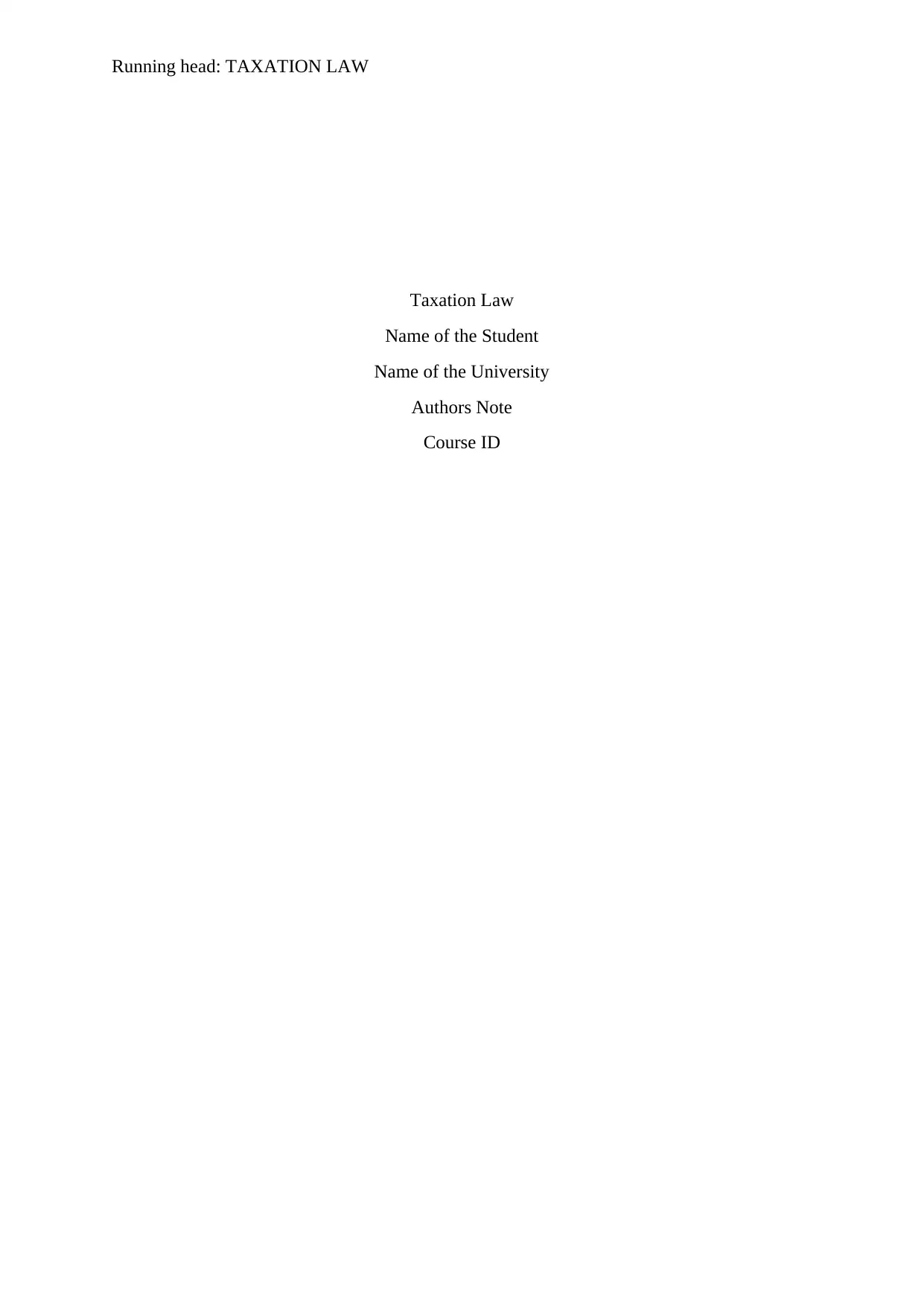
Running head: TAXATION LAW
Taxation Law
Name of the Student
Name of the University
Authors Note
Course ID
Taxation Law
Name of the Student
Name of the University
Authors Note
Course ID
Paraphrase This Document
Need a fresh take? Get an instant paraphrase of this document with our AI Paraphraser

1TAXATION LAW
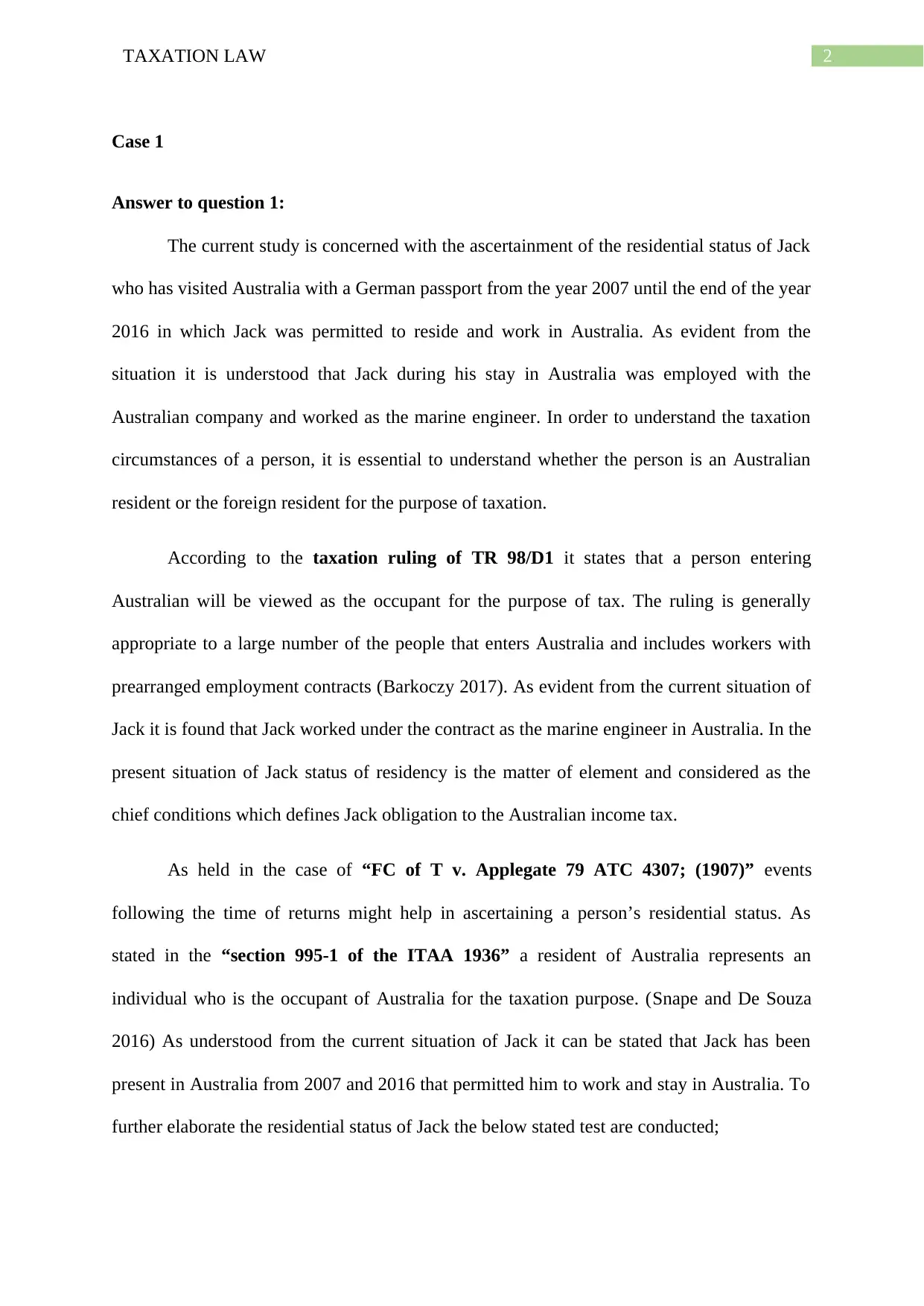
2TAXATION LAW
Case 1
Answer to question 1:
The current study is concerned with the ascertainment of the residential status of Jack
who has visited Australia with a German passport from the year 2007 until the end of the year
2016 in which Jack was permitted to reside and work in Australia. As evident from the
situation it is understood that Jack during his stay in Australia was employed with the
Australian company and worked as the marine engineer. In order to understand the taxation
circumstances of a person, it is essential to understand whether the person is an Australian
resident or the foreign resident for the purpose of taxation.
According to the taxation ruling of TR 98/D1 it states that a person entering
Australian will be viewed as the occupant for the purpose of tax. The ruling is generally
appropriate to a large number of the people that enters Australia and includes workers with
prearranged employment contracts (Barkoczy 2017). As evident from the current situation of
Jack it is found that Jack worked under the contract as the marine engineer in Australia. In the
present situation of Jack status of residency is the matter of element and considered as the
chief conditions which defines Jack obligation to the Australian income tax.
As held in the case of “FC of T v. Applegate 79 ATC 4307; (1907)” events
following the time of returns might help in ascertaining a person’s residential status. As
stated in the “section 995-1 of the ITAA 1936” a resident of Australia represents an
individual who is the occupant of Australia for the taxation purpose. (Snape and De Souza
2016) As understood from the current situation of Jack it can be stated that Jack has been
present in Australia from 2007 and 2016 that permitted him to work and stay in Australia. To
further elaborate the residential status of Jack the below stated test are conducted;
Case 1
Answer to question 1:
The current study is concerned with the ascertainment of the residential status of Jack
who has visited Australia with a German passport from the year 2007 until the end of the year
2016 in which Jack was permitted to reside and work in Australia. As evident from the
situation it is understood that Jack during his stay in Australia was employed with the
Australian company and worked as the marine engineer. In order to understand the taxation
circumstances of a person, it is essential to understand whether the person is an Australian
resident or the foreign resident for the purpose of taxation.
According to the taxation ruling of TR 98/D1 it states that a person entering
Australian will be viewed as the occupant for the purpose of tax. The ruling is generally
appropriate to a large number of the people that enters Australia and includes workers with
prearranged employment contracts (Barkoczy 2017). As evident from the current situation of
Jack it is found that Jack worked under the contract as the marine engineer in Australia. In the
present situation of Jack status of residency is the matter of element and considered as the
chief conditions which defines Jack obligation to the Australian income tax.
As held in the case of “FC of T v. Applegate 79 ATC 4307; (1907)” events
following the time of returns might help in ascertaining a person’s residential status. As
stated in the “section 995-1 of the ITAA 1936” a resident of Australia represents an
individual who is the occupant of Australia for the taxation purpose. (Snape and De Souza
2016) As understood from the current situation of Jack it can be stated that Jack has been
present in Australia from 2007 and 2016 that permitted him to work and stay in Australia. To
further elaborate the residential status of Jack the below stated test are conducted;
⊘ This is a preview!⊘
Do you want full access?
Subscribe today to unlock all pages.

Trusted by 1+ million students worldwide
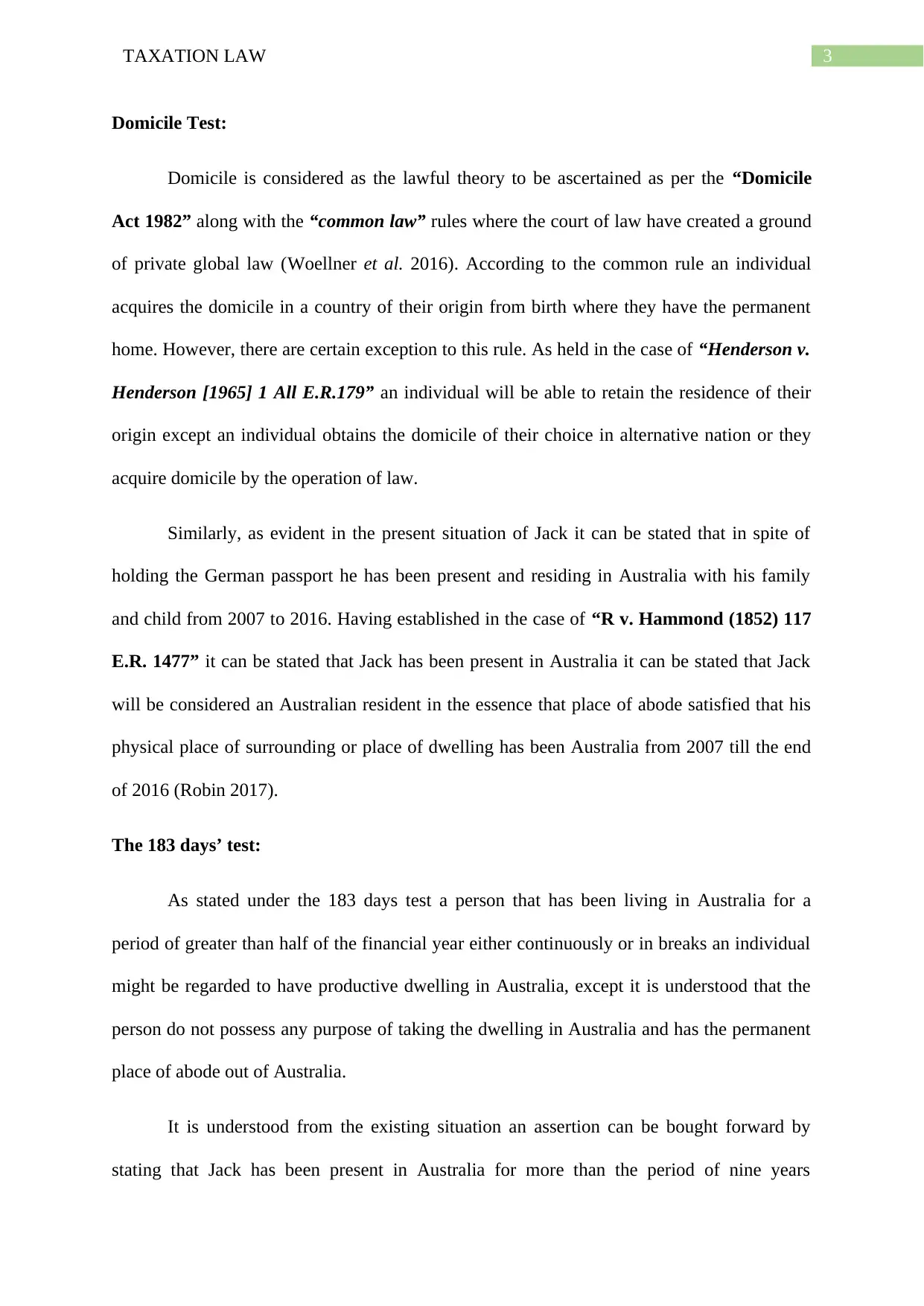
3TAXATION LAW
Domicile Test:
Domicile is considered as the lawful theory to be ascertained as per the “Domicile
Act 1982” along with the “common law” rules where the court of law have created a ground
of private global law (Woellner et al. 2016). According to the common rule an individual
acquires the domicile in a country of their origin from birth where they have the permanent
home. However, there are certain exception to this rule. As held in the case of “Henderson v.
Henderson [1965] 1 All E.R.179” an individual will be able to retain the residence of their
origin except an individual obtains the domicile of their choice in alternative nation or they
acquire domicile by the operation of law.
Similarly, as evident in the present situation of Jack it can be stated that in spite of
holding the German passport he has been present and residing in Australia with his family
and child from 2007 to 2016. Having established in the case of “R v. Hammond (1852) 117
E.R. 1477” it can be stated that Jack has been present in Australia it can be stated that Jack
will be considered an Australian resident in the essence that place of abode satisfied that his
physical place of surrounding or place of dwelling has been Australia from 2007 till the end
of 2016 (Robin 2017).
The 183 days’ test:
As stated under the 183 days test a person that has been living in Australia for a
period of greater than half of the financial year either continuously or in breaks an individual
might be regarded to have productive dwelling in Australia, except it is understood that the
person do not possess any purpose of taking the dwelling in Australia and has the permanent
place of abode out of Australia.
It is understood from the existing situation an assertion can be bought forward by
stating that Jack has been present in Australia for more than the period of nine years
Domicile Test:
Domicile is considered as the lawful theory to be ascertained as per the “Domicile
Act 1982” along with the “common law” rules where the court of law have created a ground
of private global law (Woellner et al. 2016). According to the common rule an individual
acquires the domicile in a country of their origin from birth where they have the permanent
home. However, there are certain exception to this rule. As held in the case of “Henderson v.
Henderson [1965] 1 All E.R.179” an individual will be able to retain the residence of their
origin except an individual obtains the domicile of their choice in alternative nation or they
acquire domicile by the operation of law.
Similarly, as evident in the present situation of Jack it can be stated that in spite of
holding the German passport he has been present and residing in Australia with his family
and child from 2007 to 2016. Having established in the case of “R v. Hammond (1852) 117
E.R. 1477” it can be stated that Jack has been present in Australia it can be stated that Jack
will be considered an Australian resident in the essence that place of abode satisfied that his
physical place of surrounding or place of dwelling has been Australia from 2007 till the end
of 2016 (Robin 2017).
The 183 days’ test:
As stated under the 183 days test a person that has been living in Australia for a
period of greater than half of the financial year either continuously or in breaks an individual
might be regarded to have productive dwelling in Australia, except it is understood that the
person do not possess any purpose of taking the dwelling in Australia and has the permanent
place of abode out of Australia.
It is understood from the existing situation an assertion can be bought forward by
stating that Jack has been present in Australia for more than the period of nine years
Paraphrase This Document
Need a fresh take? Get an instant paraphrase of this document with our AI Paraphraser
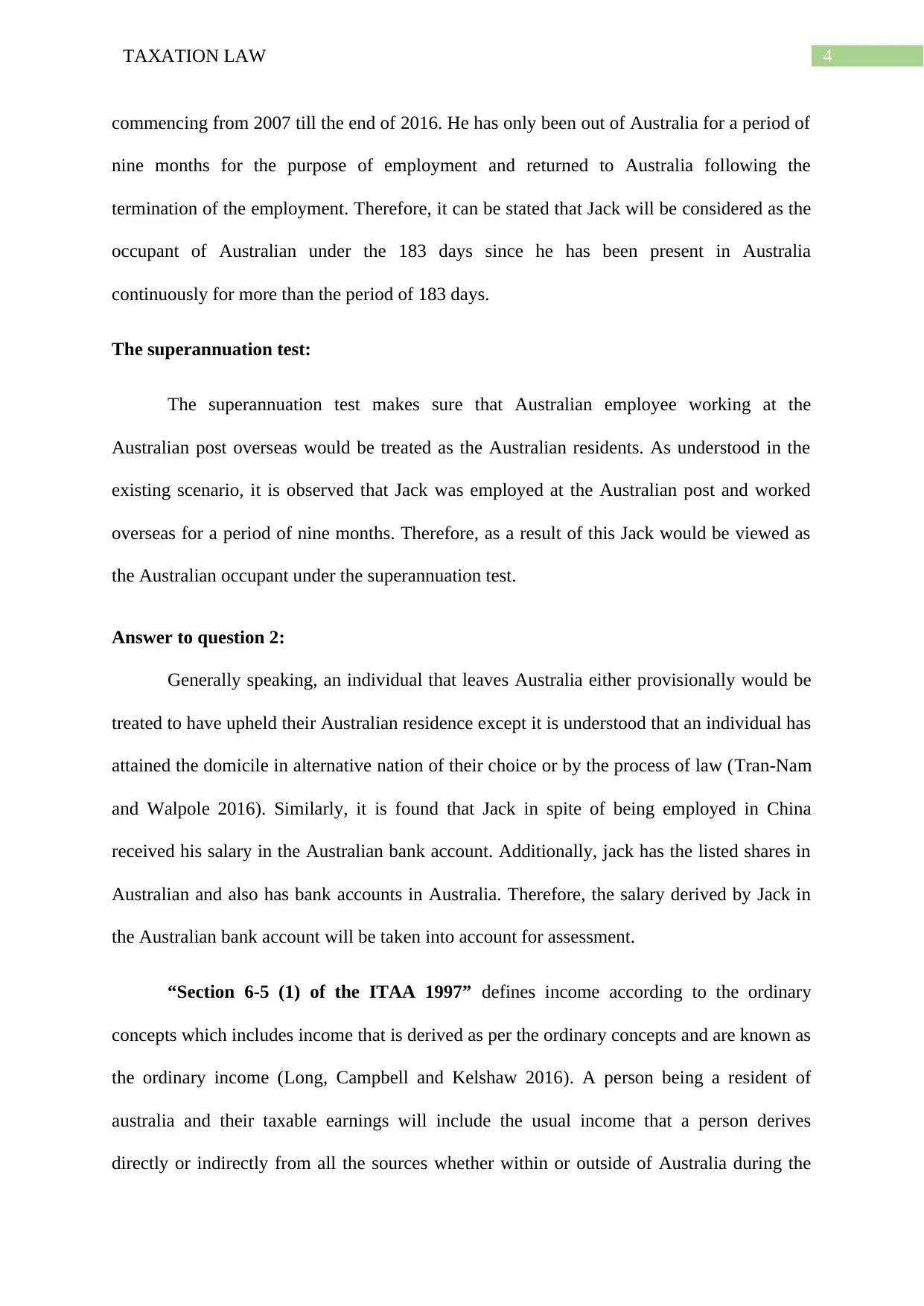
4TAXATION LAW
commencing from 2007 till the end of 2016. He has only been out of Australia for a period of
nine months for the purpose of employment and returned to Australia following the
termination of the employment. Therefore, it can be stated that Jack will be considered as the
occupant of Australian under the 183 days since he has been present in Australia
continuously for more than the period of 183 days.
The superannuation test:
The superannuation test makes sure that Australian employee working at the
Australian post overseas would be treated as the Australian residents. As understood in the
existing scenario, it is observed that Jack was employed at the Australian post and worked
overseas for a period of nine months. Therefore, as a result of this Jack would be viewed as
the Australian occupant under the superannuation test.
Answer to question 2:
Generally speaking, an individual that leaves Australia either provisionally would be
treated to have upheld their Australian residence except it is understood that an individual has
attained the domicile in alternative nation of their choice or by the process of law (Tran-Nam
and Walpole 2016). Similarly, it is found that Jack in spite of being employed in China
received his salary in the Australian bank account. Additionally, jack has the listed shares in
Australian and also has bank accounts in Australia. Therefore, the salary derived by Jack in
the Australian bank account will be taken into account for assessment.
“Section 6-5 (1) of the ITAA 1997” defines income according to the ordinary
concepts which includes income that is derived as per the ordinary concepts and are known as
the ordinary income (Long, Campbell and Kelshaw 2016). A person being a resident of
australia and their taxable earnings will include the usual income that a person derives
directly or indirectly from all the sources whether within or outside of Australia during the
commencing from 2007 till the end of 2016. He has only been out of Australia for a period of
nine months for the purpose of employment and returned to Australia following the
termination of the employment. Therefore, it can be stated that Jack will be considered as the
occupant of Australian under the 183 days since he has been present in Australia
continuously for more than the period of 183 days.
The superannuation test:
The superannuation test makes sure that Australian employee working at the
Australian post overseas would be treated as the Australian residents. As understood in the
existing scenario, it is observed that Jack was employed at the Australian post and worked
overseas for a period of nine months. Therefore, as a result of this Jack would be viewed as
the Australian occupant under the superannuation test.
Answer to question 2:
Generally speaking, an individual that leaves Australia either provisionally would be
treated to have upheld their Australian residence except it is understood that an individual has
attained the domicile in alternative nation of their choice or by the process of law (Tran-Nam
and Walpole 2016). Similarly, it is found that Jack in spite of being employed in China
received his salary in the Australian bank account. Additionally, jack has the listed shares in
Australian and also has bank accounts in Australia. Therefore, the salary derived by Jack in
the Australian bank account will be taken into account for assessment.
“Section 6-5 (1) of the ITAA 1997” defines income according to the ordinary
concepts which includes income that is derived as per the ordinary concepts and are known as
the ordinary income (Long, Campbell and Kelshaw 2016). A person being a resident of
australia and their taxable earnings will include the usual income that a person derives
directly or indirectly from all the sources whether within or outside of Australia during the
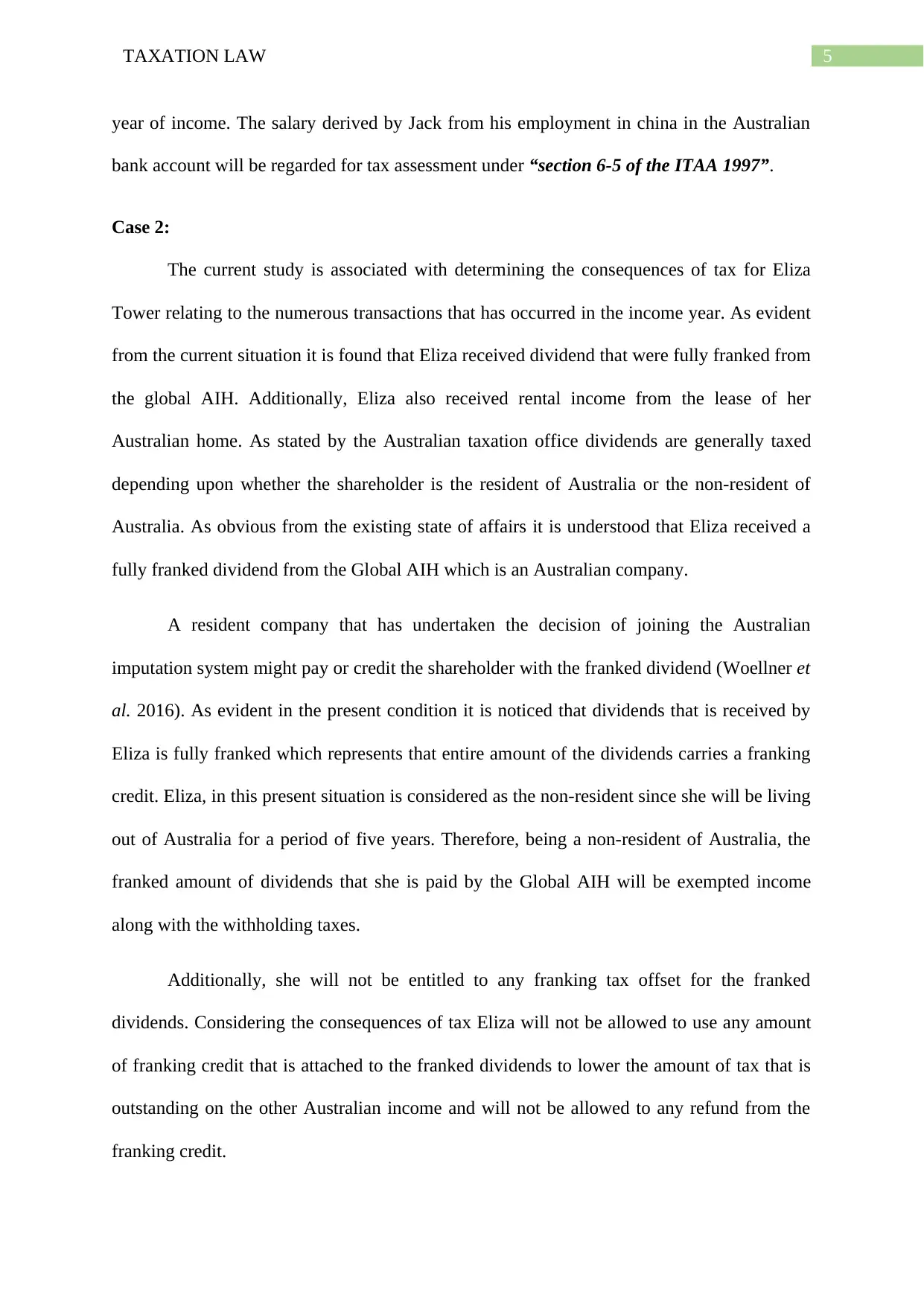
5TAXATION LAW
year of income. The salary derived by Jack from his employment in china in the Australian
bank account will be regarded for tax assessment under “section 6-5 of the ITAA 1997”.
Case 2:
The current study is associated with determining the consequences of tax for Eliza
Tower relating to the numerous transactions that has occurred in the income year. As evident
from the current situation it is found that Eliza received dividend that were fully franked from
the global AIH. Additionally, Eliza also received rental income from the lease of her
Australian home. As stated by the Australian taxation office dividends are generally taxed
depending upon whether the shareholder is the resident of Australia or the non-resident of
Australia. As obvious from the existing state of affairs it is understood that Eliza received a
fully franked dividend from the Global AIH which is an Australian company.
A resident company that has undertaken the decision of joining the Australian
imputation system might pay or credit the shareholder with the franked dividend (Woellner et
al. 2016). As evident in the present condition it is noticed that dividends that is received by
Eliza is fully franked which represents that entire amount of the dividends carries a franking
credit. Eliza, in this present situation is considered as the non-resident since she will be living
out of Australia for a period of five years. Therefore, being a non-resident of Australia, the
franked amount of dividends that she is paid by the Global AIH will be exempted income
along with the withholding taxes.
Additionally, she will not be entitled to any franking tax offset for the franked
dividends. Considering the consequences of tax Eliza will not be allowed to use any amount
of franking credit that is attached to the franked dividends to lower the amount of tax that is
outstanding on the other Australian income and will not be allowed to any refund from the
franking credit.
year of income. The salary derived by Jack from his employment in china in the Australian
bank account will be regarded for tax assessment under “section 6-5 of the ITAA 1997”.
Case 2:
The current study is associated with determining the consequences of tax for Eliza
Tower relating to the numerous transactions that has occurred in the income year. As evident
from the current situation it is found that Eliza received dividend that were fully franked from
the global AIH. Additionally, Eliza also received rental income from the lease of her
Australian home. As stated by the Australian taxation office dividends are generally taxed
depending upon whether the shareholder is the resident of Australia or the non-resident of
Australia. As obvious from the existing state of affairs it is understood that Eliza received a
fully franked dividend from the Global AIH which is an Australian company.
A resident company that has undertaken the decision of joining the Australian
imputation system might pay or credit the shareholder with the franked dividend (Woellner et
al. 2016). As evident in the present condition it is noticed that dividends that is received by
Eliza is fully franked which represents that entire amount of the dividends carries a franking
credit. Eliza, in this present situation is considered as the non-resident since she will be living
out of Australia for a period of five years. Therefore, being a non-resident of Australia, the
franked amount of dividends that she is paid by the Global AIH will be exempted income
along with the withholding taxes.
Additionally, she will not be entitled to any franking tax offset for the franked
dividends. Considering the consequences of tax Eliza will not be allowed to use any amount
of franking credit that is attached to the franked dividends to lower the amount of tax that is
outstanding on the other Australian income and will not be allowed to any refund from the
franking credit.
⊘ This is a preview!⊘
Do you want full access?
Subscribe today to unlock all pages.

Trusted by 1+ million students worldwide
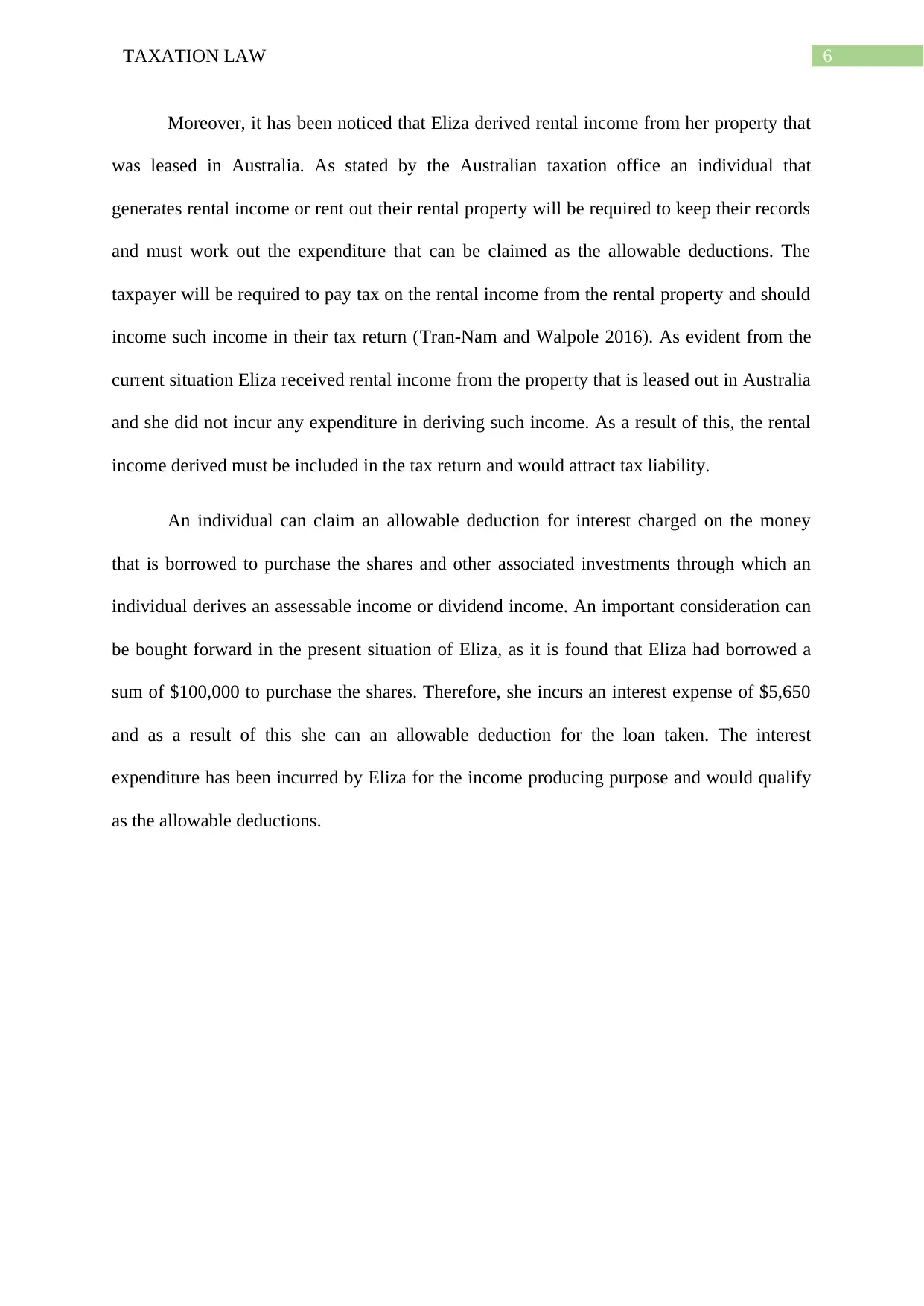
6TAXATION LAW
Moreover, it has been noticed that Eliza derived rental income from her property that
was leased in Australia. As stated by the Australian taxation office an individual that
generates rental income or rent out their rental property will be required to keep their records
and must work out the expenditure that can be claimed as the allowable deductions. The
taxpayer will be required to pay tax on the rental income from the rental property and should
income such income in their tax return (Tran-Nam and Walpole 2016). As evident from the
current situation Eliza received rental income from the property that is leased out in Australia
and she did not incur any expenditure in deriving such income. As a result of this, the rental
income derived must be included in the tax return and would attract tax liability.
An individual can claim an allowable deduction for interest charged on the money
that is borrowed to purchase the shares and other associated investments through which an
individual derives an assessable income or dividend income. An important consideration can
be bought forward in the present situation of Eliza, as it is found that Eliza had borrowed a
sum of $100,000 to purchase the shares. Therefore, she incurs an interest expense of $5,650
and as a result of this she can an allowable deduction for the loan taken. The interest
expenditure has been incurred by Eliza for the income producing purpose and would qualify
as the allowable deductions.
Moreover, it has been noticed that Eliza derived rental income from her property that
was leased in Australia. As stated by the Australian taxation office an individual that
generates rental income or rent out their rental property will be required to keep their records
and must work out the expenditure that can be claimed as the allowable deductions. The
taxpayer will be required to pay tax on the rental income from the rental property and should
income such income in their tax return (Tran-Nam and Walpole 2016). As evident from the
current situation Eliza received rental income from the property that is leased out in Australia
and she did not incur any expenditure in deriving such income. As a result of this, the rental
income derived must be included in the tax return and would attract tax liability.
An individual can claim an allowable deduction for interest charged on the money
that is borrowed to purchase the shares and other associated investments through which an
individual derives an assessable income or dividend income. An important consideration can
be bought forward in the present situation of Eliza, as it is found that Eliza had borrowed a
sum of $100,000 to purchase the shares. Therefore, she incurs an interest expense of $5,650
and as a result of this she can an allowable deduction for the loan taken. The interest
expenditure has been incurred by Eliza for the income producing purpose and would qualify
as the allowable deductions.
Paraphrase This Document
Need a fresh take? Get an instant paraphrase of this document with our AI Paraphraser
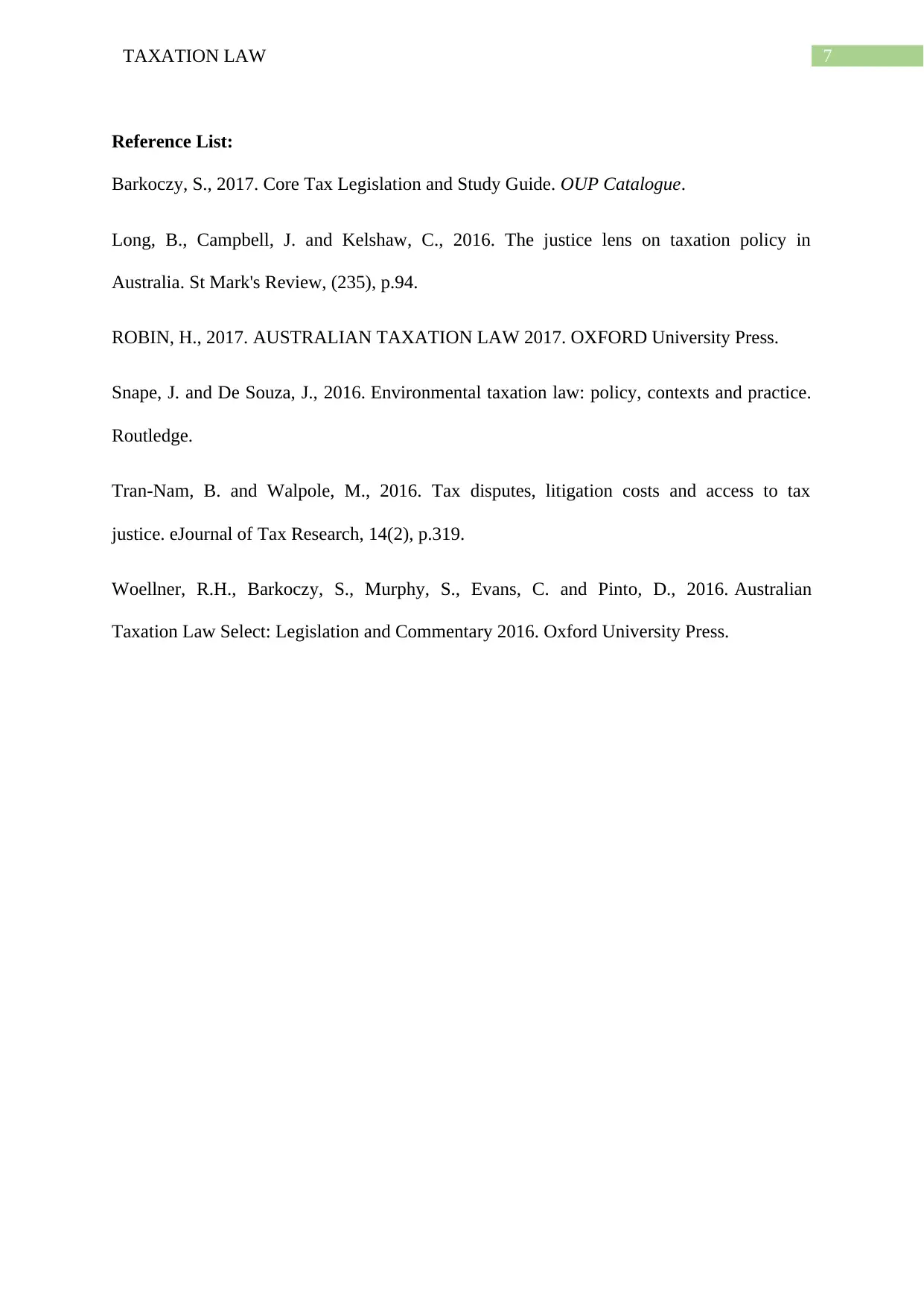
7TAXATION LAW
Reference List:
Barkoczy, S., 2017. Core Tax Legislation and Study Guide. OUP Catalogue.
Long, B., Campbell, J. and Kelshaw, C., 2016. The justice lens on taxation policy in
Australia. St Mark's Review, (235), p.94.
ROBIN, H., 2017. AUSTRALIAN TAXATION LAW 2017. OXFORD University Press.
Snape, J. and De Souza, J., 2016. Environmental taxation law: policy, contexts and practice.
Routledge.
Tran-Nam, B. and Walpole, M., 2016. Tax disputes, litigation costs and access to tax
justice. eJournal of Tax Research, 14(2), p.319.
Woellner, R.H., Barkoczy, S., Murphy, S., Evans, C. and Pinto, D., 2016. Australian
Taxation Law Select: Legislation and Commentary 2016. Oxford University Press.
Reference List:
Barkoczy, S., 2017. Core Tax Legislation and Study Guide. OUP Catalogue.
Long, B., Campbell, J. and Kelshaw, C., 2016. The justice lens on taxation policy in
Australia. St Mark's Review, (235), p.94.
ROBIN, H., 2017. AUSTRALIAN TAXATION LAW 2017. OXFORD University Press.
Snape, J. and De Souza, J., 2016. Environmental taxation law: policy, contexts and practice.
Routledge.
Tran-Nam, B. and Walpole, M., 2016. Tax disputes, litigation costs and access to tax
justice. eJournal of Tax Research, 14(2), p.319.
Woellner, R.H., Barkoczy, S., Murphy, S., Evans, C. and Pinto, D., 2016. Australian
Taxation Law Select: Legislation and Commentary 2016. Oxford University Press.
1 out of 8
Related Documents
Your All-in-One AI-Powered Toolkit for Academic Success.
+13062052269
info@desklib.com
Available 24*7 on WhatsApp / Email
![[object Object]](/_next/static/media/star-bottom.7253800d.svg)
Unlock your academic potential
Copyright © 2020–2025 A2Z Services. All Rights Reserved. Developed and managed by ZUCOL.





